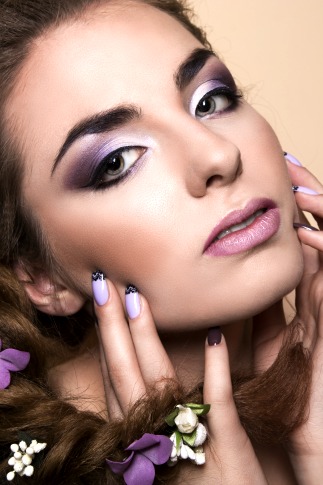Whether you’re just starting out or are a seasoned professional, a proper portfolio is essential for growth in the makeup industry. As powerful as word of mouth can be, a potential client will be unlikely to hire you based on words alone. They will need to see some proof that you are capable of meeting their specific expectations. That is where your portfolio comes in.

Digital vs paper
Being that we are in digital age, a paper portfolio with actual photographs and tear-sheets is not as necessary today as a great web, or tablet version is. I am not suggesting that some clients would not prefer to review your physical portfolio—in fact some old school companies still request this format, but it is becoming increasingly rare. As a great starting point, focus on building a portfolio you can share on your tablet and website. You can always create a physical version later if you begin working with an agent who requires it.
Be consistent
Now to make your portfolio work best for you, you have to have a focus. This doesn’t mean you cannot work in more than one area, but if they are vastly different, you may wish you have two separate portfolios or weblinks for each one. Showing more work is not valuable if the work you are presenting is different from what the potential client would like to see. For example, if you have a portfolio that features beautiful variations of bridal work and you pepper in your special effects, you will likely not secure that bridal client.
No matter how good your bridal work is, a huge contrast in genres would likely create questions in their mind. When people are looking to hire someone, they are naturally attracted to focus.
In the beginning, it is always best to hone in on one or two areas so you can really corner the market and make a name for yourself. Once you have a solid reputation, it will be very easy to build another portfolio and laterally transition to different area of makeup.
Tailor to clients
Don’t be afraid to customize your portfolio for each type of potential client. Consider having bridal and select natural beauty looks in a portfolio for brides; beauty, high fashion, and avant-garde in a portfolio for editorial; and theatre, TV, film and special effects work in their own separate category. There is no shame in having multiple portfolios. Just know just who to show them to.
Digital is on your side to make this very easy. In your tablet, you can easily upload images to create the portfolio you need for each and every client on a case by case basis. It will be a few extra minutes of work, but when that effort begins landing you all the jobs, you’ll be glad you did it. For example, the work you might choose to show for a L’Oréal beauty advertisement will likely be different than what you show if you are aiming for an editorial in Nylon.

If you created a portfolio specifically geared toward each of those jobs, the team reviewing your work will likely see you as a perfect fit. Think of it as a puzzle … use the pieces you need at any given time to land the job you desire.
Use portfolio-ready photos
Image quality is essential. In the beginning, you may have to use photographs that you take yourself, but immediately replace them with professional images as you acquire them. The more professional images you have, the more likely you are to book the client.
Professional photos always look better than the ones you take yourself. They also tell the client that you are a professional who works well with other professionals. Also, to ensure that professionals want to continue working with you, always ask permission to use their work and credit them appropriately.
A word of warning: If you are using shots you have taken of your own work, do not put up any images that show your client from every angle and with their eyes closed. Despite what you may see on Instagram, it is very, very rare to display images like that in the professional world. People with even just a touch of experience in the industry generally see it as the mark of a novice. You want to give your potential clients the sense that you are an experienced professional—even if you are new to the industry.
Remember, no brides, models, celebrities, or actresses walk around with their eyes closed to show off their makeup. If your makeup does not look great when your model’s eyes are open, you did something wrong. Wash the face and start again!

Keep it relevant!
Variety is a necessity. If you want to work with brides, you should eventually plan to have a variety of bridal looks including a wide range of natural, moderate, and more glamorous looks. You will also want to be sure you have a variety of skin tones.
Keep your portfolio current. All the images should be either classic looks or looks that are currently in demand. Even if you did a big and impressive job 15 years ago, the makeup may not still be in style. No matter how much it hurts your heart, you have to tuck that image away until the look is back on trend!
Showcase your best work
Every image should be strong. Even if you only have one or two strong contenders right now, it is better to have a small portfolio with a 100% ratio of beautiful images than to beef it up with work that is of lesser quality. If a client sees two beautiful images, they are more likely to consider taking a chance on you than if you have a bigger portfolio with a lesser percentage of professional level work.
If someone shows a weak image amongst strong ones it tells potential clients several things. First, that the artist doesn’t know how to gauge the quality of their own work. And second, they do not always do professional level work. Prevent any doubt in your professional abilities by ensuring that only your best work is visible to potential clients.
And don’t forget, even though all of your work will be topnotch, lead with the images you are proudest of! Make a great impression from image one, and keep that impression going, even if it is only starts with just a few! Don’t worry, if you keep working, you’ll have more to add soon enough.

A portfolio can take your career to a whole new level, so make sure it adequately reflects what you are capable of. If you need guidance with your first few shoots, consider enrolling in QC Beauty Academy’s Portfolio Development course for makeup artists.
